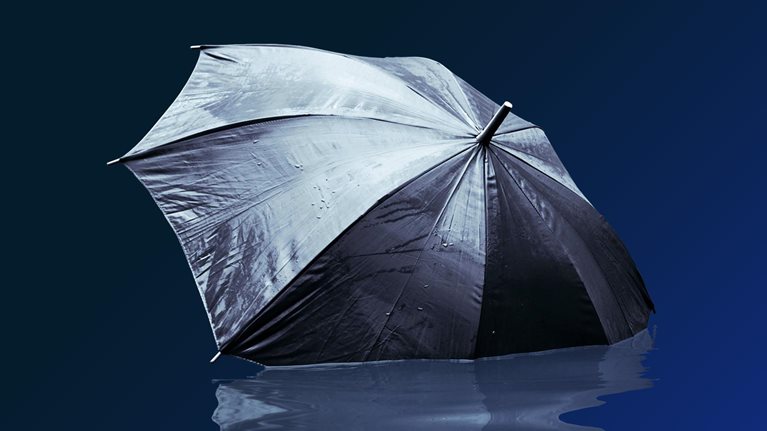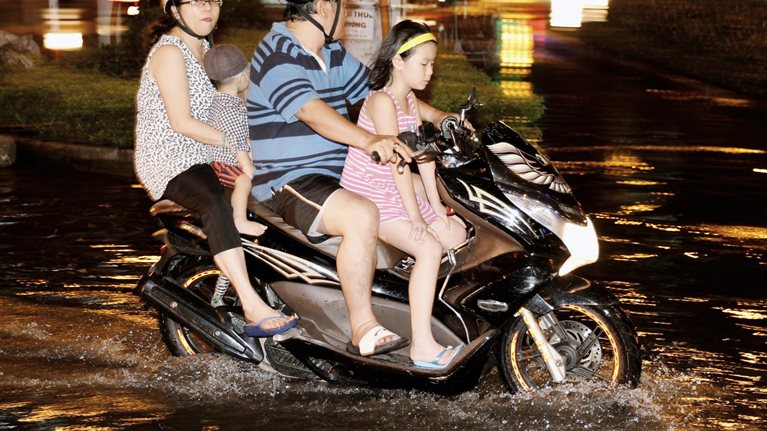Much of global economic production is organized around a complex system of interdependent supply chains. Supply chains facilitate the production of everything from computers and cars to lifesaving medicines and food, and support world trade in goods that is worth almost $20 trillion annually. End products have up to many thousands of parts, sourced from diverse geographies around the world. Over time, these supply chains have been honed to deliver maximum efficiency and speed.
But questions about supply-chain risks and resilience are now being raised in the context of the global COVID-19 pandemic as well as acute weather events. As climate change makes extreme weather more frequent and/or severe, it increases the annual probability of events that are more intense than manufacturing assets are constructed to withstand, increasing the likelihood of supply-chain disruptions.
Recent MGI research examines how industry value chains are exposed to a broader set of risks, including climate events. This work also examines vulnerabilities within specific companies and broader value chains, financial losses, and ways to bolster resilience.
In this case study, we examine how risks from climate hazards, already present in global supply chains, are likely to evolve over the next few decades (see sidebar, “An overview of the case study analysis”). We identify three broad types of supply chains: specialty, intermediate, and commodity. Typically, the more specialized the supply chain, the more severe the impact could be for a downstream player as supply of a critical input may only be available from the source that has been disrupted. However, the more commoditized the supply chain is, the larger the number of downstream players that may be affected by spiking prices from a sudden reduction in supply (Exhibit 1).

For a deeper appreciation of the extent of risks, we focus on two supply chains that illustrate how disruption may play out. As an example of specialty supply chains, we examine the semiconductor industry; for commodity supply chains, heavy rare earth metals. Both create critical inputs for advanced industries. Semiconductor chips are ubiquitous in electronics from computers to smartphones to electronic watches. Rare earths are critical in aerospace and defense, electric vehicles, wind turbines, drones, medical appliances, and other electronics. Both supply chains are highly geographically concentrated in regions with an increasing probability of relevant climate hazards. However, these are only examples illustrating broader trends.

Climate risk and response
Learn how earth’s changing climate could impact socioeconomic systems
The probability of a hurricane of sufficient intensity to disrupt semiconductor supply chains may grow two to four times by 2040
By 2040, a company using leading-edge chips (for example, with applications in memory, logic, communication, or optoelectronics) such as an automotive OEM, sourcing from geographies in Korea, Japan, Taiwan, or other hubs in the western Pacific, can expect that hurricanes sufficient to disrupt their suppliers will become two to four times more likely. Some of these disruptions may last for several months. This has implications for many industries as chips are increasingly critical to the modern economy. For example, electrical content in cars increased from 2 percent in 1960 to 35 percent in 2010.
There are three drivers of near-term losses for suppliers that are hit by such events, potentially leading to losses of up to 200 percent of annual profit and 35 percent of revenues: physical damages to assets, including facilities, production equipment, and inventories; reduced sales, either because production is disrupted or because goods cannot be shipped to the market; and higher costs in the reconstruction phase and after the plant is back in production, as market prices of labor, energy, and logistics may spike following a disaster. The combination of these impacts may also limit suppliers’ ability to quickly and efficiently restore production, by reducing their ability to raise capital for repairs or by choking short-term cash flow and presenting unusual operational obstacles.
Semiconductor supply could be reduced by an extreme hurricane in several ways: loss of infrastructure services such as roads or power, direct damages to manufacturing assets, and damages to critical internal systems such as specialized equipment. We find that a severe supply disruption can cause cascading production disruptions downstream, particularly for unprepared players (Exhibit 2). Using a hypothetical example, we estimate that downstream players could lose up to a third of annual revenue if supply is disrupted for an illustrative period of five months. This could be the case if no alternative source or substitute was able to keep supply going (beyond a minimal inventory of finished goods) and if no measures had been taken to limit losses from disrupted downstream production (for example, insurance or negotiations with customers to delay supply).

A well-prepared player, on the other hand, may only lose about 5 percent of revenue in a similar event. Preparations may include dual sourcing (so only 50 percent of supply is lost), increasing supplier resiliency through due diligence and collaboration with suppliers on asset hardening; this can limit the recovery time to less than one month. Several other actions can help further reduce the losses, including insurance, even faster recovery through best practice emergency procedures, and discounted cross-selling of substitute products (for example, premium models or older product versions) to end consumers. These adaptations come with a cost that needs to be considered, but many of these investments may be smaller than the loss avoided.
There are two key areas of adaptation for semiconductor supply chains: building disaster-proof plants (for producers) and raising inventory levels in order to continue production even if a supply chain is interrupted (for downstream players). We find that building disaster-proof plants means additional costs of roughly 2 percent of the building costs which equals an additional $20 million for an average plant. Raising the inventory to provide a meaningful buffer in case of supply disruption, with estimated costs for warehousing and working capital, could increase input costs by less than a percent.
The probability heavy rare earths production is severely disrupted from extreme rainfall may increase 2 to 3 times by 2030
Heavy rare earths production is concentrated in southeastern China, which is increasingly exposed to extreme rainfall. We find that heavy rare earth production in southeastern China will experience extreme precipitation events (defined as events that occurred historically with an annual probability of about 2 percent, corresponding to precipitation of about 170 millimeters per day in the relevant region) twice as often by 2030. Expert estimates and historical events indicate that such rainfall events significantly increase the risk of landslides in the region.
We estimate that the manifestation of an extreme precipitation event, or series of events, could cause at least a 20 percent drop in heavy rare earth output, and potentially much more in a worst-case scenario. Damage mechanisms include excessive mud and landslides in mines, flooding treatment ponds, and disrupted logistics to and from mines. Landslides are of particular concern, as they could both disrupt the ongoing leaching process in the mine if leach holes collapse and prevent production after the landslide if on-site repair works are required before new leach holes are dug (for example, to make sure that the soil has stabilized). This means a large landslide could disrupt production for up to 12 months in severely hit mines, though for most mines the disruption would be shorter if the landslide is shallow and only affects parts of the mine.
Even a limited supply shortfall could cause prices to rise substantially (Exhibit 3). During the supply crisis in 2010–11, prices of several rare earths increased more than ten times. Since the supply shortages, some rare earth consumers have attempted to build stockpiles in case of price spikes, but public data on the scale of the stockpiling are scarce. For downstream players without substantial inventories, a price spike would mean they either have to reduce their consumption of heavy rare earths or increase their spending.

A supply shortfall would be more critical for some heavy rare earths than others. Since the supply shortage in 2010–11, significant effort has been put into researching alternatives to rare earths, but with limited success in the key application areas. Going forward, there is concern about whether supply for some of these rare earth elements can keep up with demand for the materials that are used in high-growth segments like cleantech and consumer electronics, as well as high-end segments like aerospace and defense and medical appliances. Disruptions from climatic disruptions will add extra pressure to a supply chain that has little to no slack.
Downstream players dependent on rare earths can protect themselves from climate-change induced physical risk by raising inventory levels at the cost of additional working capital and storage space needed, similar to the semiconductor example above. Rare earth miners can also adapt in other ways, for example, by using different leaching products and processes that decrease the risk of landslides or moving leach holes away from the steepest slopes. We estimate these measures could increase COGS by less than 5 percent.
Other adaptation measures could slightly decrease the output of the mines: one option would be to select sites in areas with a lower concentration of mines in order to diversify risk, even if these mines have marginally lower potential. For example, Yunnan and Hunan have less than 2 mines today, while there are more than 54 mines in Jiangxi. Finally, if extreme rainfall is expected, miners could extract the leach in the most mature leach holes ahead of schedule. This would limit destruction of work in progress inventory when the rainfall turns mines to mud. All adaptation measures mentioned could be implemented in the short term and would eliminate about 50 to 80 percent of risk for rare earth miners, according to our estimates.
Supply chains and the infrastructure that supports them are designed for a stable climate. As hazards evolve, it will be necessary to increase investment in adaptation, possibly at the expense of efficiency. We find significant potential for many industries to adapt in the next decade, including conducting risk diagnostics, protecting manufacturing assets, redesigning operations (for example, by increasing safety stock of key inputs), broadening supplier base, shoring up infrastructure, etc. Indeed, measures of this kind are already underway in some areas, including from public authorities, suppliers in high-hazard locations, and customers in downstream sectors.
For additional details on the risks to supply chains and possible adaptation measures, download the case study, Could climate become the weak link in your supply chain? (PDF–865KB).
About this case study:
In January 2020, the McKinsey Global Institute published Climate risk and response: Physical hazards and socioeconomic impacts. In that report, we measured the impact of climate change by the extent to which it could affect human beings, human-made physical assets, and the natural world over the next three decades. In order to link physical climate risk to socioeconomic impact, we investigated nine specific cases that illustrated exposure to climate change extremes and proximity to physical thresholds.

